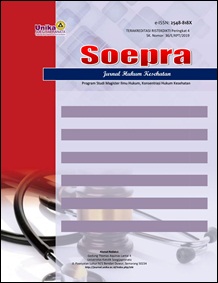Ethical and Legal Issues in the Use of Online-Based Health Services (E-Health)
Abstract
Abstract: The internet offers unprecedented power to provide users with health information for patients, health professionals, and professionals. Maintaining the integrity, data systems, and confidentiality of individual health information, quality of content, and consumer protection and the commercial interests of the health industry against unethical practices, are areas of greatest concern in the implementation and use of the Internet. However, there is no national and international legislation for regulating the use of online-based health services. This research is a Literature review that aims to explore ethical and legal issues in the use of online-based health services (E-Health). The review process begins by identifying journal articles that are relevant to the research topic. This study concludes that the use of online-based health services (E-Health) is an important public health issue. E-Health emerged as a tool for developing new diagnostics and therapeutic interventions. Ethical issues related to crossing clinical practice and online communication about health services. This allows discriminatory or unethical behavior and is not following the professional code of ethics. E-Health licensing standards and regulations have not been implemented in many countries. So that health workers are required to code of ethics in the use of online-based health services (E-Health).
Keywords
Full Text:
PDFReferences
Amelia, Fiona. (2016, September 1). Urgensi Keberadaan Kode Etik Layanan Kesehatan Online eHealth. Retrieved from http://klik dokter.com.
Stanberry BA. Legal and ethical issues in European telemedicine. European Telemedicine. 1998/99:20–25.
Mendel B. Online identity crisis. Infoworld. 1999 Oct;(18):36–37.
Smith and M. Anderson, “Social Media Use in 2018,” Pew Research Center, March 1, 2018, http://www.pewinternet.org/2018/03/01/social-media-use-in-2018/.
US Department of Health and Human Services, authors. Proposed Standards for Privacy of Individually Identifiable Health Information. 1999. http://aspe.hhs.gov/admnsimp/pvcsumm.htm.
De Jong, C. R. Lucey, and R. A. Dudley, “Incorporating a New Technology While Doing No Harm, Virtually,” Journal of the American Medical Association 314, no. 22 (2015): 2351–52.
R. Volpe et al., “Googling a Patient,” Hastings Center Report 43, no. 5 (2013): 14–15.
G. C. Bowker and S. L. Star, Sorting Things Out: Classification and Its Consequences (Cambridge, MA: MIT Press, 1999); H. K. Andreassen and K. Dyb, “Differences and Inequalities in Health: Empirical Reflections on Telemedicine and Politics,” Information Communication and Society 13, no. 7 (2010): 956-75.
Clark, Capuzzi, and Harrison, “Telemedicine: Medical, Legal and Ethical Perspectives”; E. L. Egede et al., “Psychotherapy for Depression in Older Veterans via Telemedecine: Effect on Quality of Life, Satisfaction, Treatment Credibility, and Service Delivery Perception,” Journal of Clinical Psychiatry 77, no. 12 (2016): 1704-11.
R. Martinson, “The Double-Edged Sword of Prison Video Visitation: Claiming to Keep Families Together While Furthering the Aims of the Prison Industrial Complex,” Florida A & M University Law Review 9, no. 1 (2013): 83-110.
L. Kvasny, “Cultural (Re)production of Digital Inequality in a US Community Technology Initiative,” Information Communication and Society 9, no. 2 (2006): 160-81; Andreassen and Dyb, “Differences and Inequalities in Health.”
D. Reich, “Contradictions in the Commodification of Hospital Care,” American Journal of Sociology 119, no. 6 (2014): 1576-1628.
M. Simon, “HP Looking into Claim Webcams Can’t See Black People,” CNN, December 23, 2009.
W. Kluge, “Health Information Professionals in a Global eHealth World: Ethical and Legal Arguments for the International Certification and Accreditation of Health Information Professionals,” International Journal of Medical Informatics 97 (2017): 261-65.
K. Yeung, “‘Hypernudge’: Big Data as a Mode of Regulation by Design,” Information Communication and Society 20, no. 1 (2017): 118-36.
Grady et al., “Evidence-Based Practice for Telemental Health,” Telemedicine and E-Health 17, no. 2 (2011): 131-48.
H. Kugelmass, “‘Just the Type with Whom I Like to Work’: Two Correspondence Field Experiments in an Online Mental Health Care Market,” Society and Mental Health (March 28, 2018): 1-16, at 7, doi:10.1177/2156869318755213.
S. Char, N. H. Shah, and D. Magnus, “Implementing Machine Learning in Health Care—Addressing Ethical Challenges,” New England Journal of Medicine 378, no. 11 (2018): 981-83.
J. Burgess et al., “Patient Race and Physicians’ Decisions to Prescribe Opioids for Chronic Low Back Pain,” Social Science and Medicine 67, no.11 (2008): 1852-60; H. Kugelmass, “‘Sorry, I’m Not Accepting New Patients,’” Journal of Health and Social Behavior 57, no. 2 (2016): 168-83.
C. A. Maher et al., “Are Health Behavior Change Interventions That Use Online Social Networks Effective? A Systematic Review,” Journal of Medical Internet Research 16, no. 2 (2014): 1-16.
M. Ananny and K. Crawford, “Seeing without Knowing: Limitations of the Transparency Ideal and Its Application to Algorithmic Accountability,” New Media and Society 20 (2018): 973-89.
Eubanks, Automating Inequality; Bowker and Star, Sorting Things Out; M. Harrison, R. Koppel, and S. Bar-Lev, “Unintended Consequences of Information Technologies in Healthcare—An Interactive Sociotechnical Analysis,” Journal of the American Medical Informatics Association 14 (2007): 542-49.
Lupton and Maslen, “Telemedicine and the Senses,” 1564; see also P. Måseide, “Body Work in Respiratory Physiological Examinations,” Sociology of Health and Illness 33, no. 2 (2011): 296-307.
A.D. I. Kramer, J. E. Guillory, and J. T. Hancock, “Experimental Evidence of Massive-Scale Emotional Contagion through Social Networks,” Proceedings of the National Academy of Sciences 111, no. 24 (2014): 8788-90.
Luxton, J. D. June, and J. M. Fairall, “Social Media and Suicide: A Public Health Perspective,” American Journal of Public Health 102, supplement no. 2 (2012): 195-200.
Farnan JM, Sulmasy LS, Worster BK, Chaudhry HJ, Rhyne JA, Arora VM. Online medical professionalism: Patient and public relationships: Policy statement from the American College of physicians and the federation of State Medical Boards. Ann Intern Med. 2013;158(8):620–7. doi: 10.7326/0003-4819-158-8- 201304160-00100.
N. Diviani, B. van den Putte, S. Giani, and J. C. M. van Weert, “Low Health Literacy and Evaluation of Online Health Information: A Systematic Review of the Literature,” Journal of Medical Internet Research 17, no. 5 (2015): e112.
Swartzendruber et al., “Sexual and Reproductive Health Services and Related Health Information on Pregnancy Resource Center Websites: A Statewide Content Analysis,” Women’s Health Issues 28, no. 1 (2018): 14-20.
Internet Healthcare Coalition, authors. Tips For Health Consumers Finding Quality Health Information on the Internet. 2000. http://www.ihealthcoalition.org/content/tips.html.
Pan American Health Organization, authors. Setting Up Healthcare Services Information Systems - A Guide for Requirement Analysis, Application Specification, and Procurement. Washington(DC): Essential Drugs and Technology Program, Division of Health Systems and Services Development; 1999.
Budd L. Physician tweet thyself: A guide for integrating social media into medical practice. B C Med J. 2013;55(1):38–41.
Prawiroharjo P, Libritany N. Tinjauan etika penggunaan media sosial oleh dokter. JEKI. 2017;1(1):31–4. doi: 10.26880/jeki.v1i1.7
DOI: https://doi.org/10.24167/shk.v6i1.2626
Refbacks
- There are currently no refbacks.
Copyright (c) 2020 SOEPRA Hukum Kesehatan







